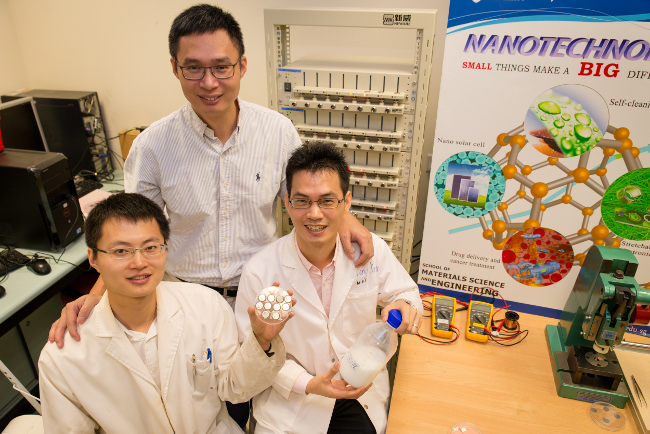Scientists in Singapore have made a breakthrough in developing a lithium-ion battery that can be charged up to 70pc in only two minutes and have a lifetime of up to 20 years.
The next big thing in battery technology was developed by scientists from Nanyang Technological University (NTU) wo replaced the traditional graphite used for the anode in lithium-ion batteries with a new gel material made from lithium dioxide.
Lithium-dioxide is a cheap material found in soil which is commonly used as a food additive or in sunscreen lotions to absorb ultraviolet rays.
The scientists found a way of pouring the material into tiny nanotubes.
The new battery will be capable of enduring 10,000 charging cycles, which is 20 times more than the current 500 cycles of today’s batteries.
A breakthrough in battery technology

(Clockwise from top) NTU Assoc Prof Chen Xiaodong with research fellow Tang Yuxin and PhD student Deng Jiyang
Invented by Associate Professor Chen Xiaodong from NTU’s School of Materials Science and Engineering, the science behind the formation of the new titanium dioxide gel was published in the latest issue of Advanced Materials, a leading international scientific journal in materials science.
Prof Chen and his team will be applying for a Proof-of-Concept grant to build a large-scale battery prototype. With the help of NTUitive, a wholly-owned subsidiary of NTU set up to support NTU start-ups, the patented technology has already attracted interest from the industry.
The technology is currently being licensed by a company for eventual production. Prof Chen expects that the new generation of fast-charging batteries will hit the market in the next two years. It also has the potential to be a key solution in overcoming longstanding power issues related to electro-mobility.
“Electric cars will be able to increase their range dramatically, with just five minutes of charging, which is on par with the time needed to pump petrol for current cars,” added Prof Chen.
“Equally important, we can now drastically cut down the toxic waste generated by disposed batteries, since our batteries last ten times longer than the current generation of lithium-ion batteries.”
Major implications for electric vehicles
The 10,000-cycle life of the new battery also mean that drivers of electric vehicles would save on the cost of battery replacements, which could cost over US$5,000 each.
According to Frost & Sullivan, a leading growth-consulting firm, the global market of rechargeable lithium-ion batteries is projected to be worth US$23.4 billion in 2016.
Lithium-ion batteries usually use additives to bind the electrodes to the anode, which affects the speed in which electrons and ions can transfer in and out of the batteries.
However, Prof Chen’s new cross-linked titanium dioxide nanotube-based electrodes eliminates the need for these additives and can pack more energy into the same amount of space.
Battery indicator image at top via Shutterstock